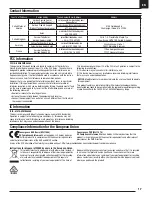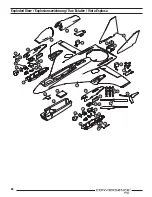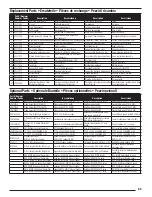
EN
5
This product requires an approved Spektrum
™
DSM2
®
/DSMX
®
compatible
transmitter. Visit
www.bindnfl y.com
for a complete list of approved transmitters.
IMPORTANT:
Before binding a transmitter, read the
Transmitter Setup
section
to ensure that your transmitter is properly programmed for this aircraft.
If you encounter problems, follow the binding instructions and refer to the
transmitter troubleshooting guide for other instructions. If needed, contact the
appropriate Horizon Product Support offi ce.
Transmitter and Receiver Binding
Binding Procedure
CAUTION:
When using a Futaba
®
transmitter with a Spektrum DSM2
module, you must reverse the throttle channel and rebind. Refer to your
Spektrum module manual for binding and failsafe instructions. Refer to your
Futaba transmitter manual for instructions on reversing the throttle channel.
1. Make sure the transmitter is powered off.
2. Center all trims and move the throttle stick to the lowest position.
3. Place the aircraft on a level surface. Connect the fl ight battery to the fl ight
controller. The fl ight controller will produce a series of tones indicating it
is initializing. The motor nacelles will rotate to the mid-transition point and
then to the near-upright, multirotor position.
IMPORTANT:
The fl ight controller will not power the receiver on until the
fl ight controller is fully initialized, indicated by the motor nacelles rotating to
the multirotor position.
When the nacelles reach the multirotor position the receiver is ready to bind.
4. Take 3 steps away from the aircraft/receiver and then power ON the
transmitter in bind mode. Refer to your transmitter’s manual for specifi c
binding instructions.
5. The receiver is bound to the transmitter when the LED on the receiver
glows solid orange.
IMPORTANT:
The fl ight controller will not arm the ESCs if the throttle is not
in the lowest position and the throttle trim at or below center.
6. Power cycle the aircraft by unplugging and plugging in the fl ight battery to
the fl ight controller. The fl ight controller will initialize again.
IMPORTANT:
The aircraft will not respond to transmitter input until the
receiver is power cycled.
IMPORTANT:
After binding the receiver and transmitter for the fi rst time, the
transmitter must be powered on fi rst, before the aircraft. Failure to power
on the transmitter fi rst will cause the receiver to automatically go into bind
mode and requiring the transmitter and receiver to have to be re-bound.
Control Horn and Servo Arm Settings
The table to the right shows the factory settings for the control horns and
servo arms. Fly the aircraft at factory settings before making any changes to
the elevon linkages.
CAUTION:
Do not change the length of the motor nacelle control
linkages or their positions on the servo horns. Changing the linkages
could cause a loss of control and possibly a crash. Crash damage is not
covered under warranty.
Control Horns
Servo Arms
Elevons
Motor
Nacelles
Air plane fl ight position
Motor position may vary slightly depending on aircraft orientation and
current fl ight mode.
Transition position
Mu ltirotor position
Motor position may vary slightly depending on aircraft orientation and
current fl ight mode.
Motor Nacelle Positions




















